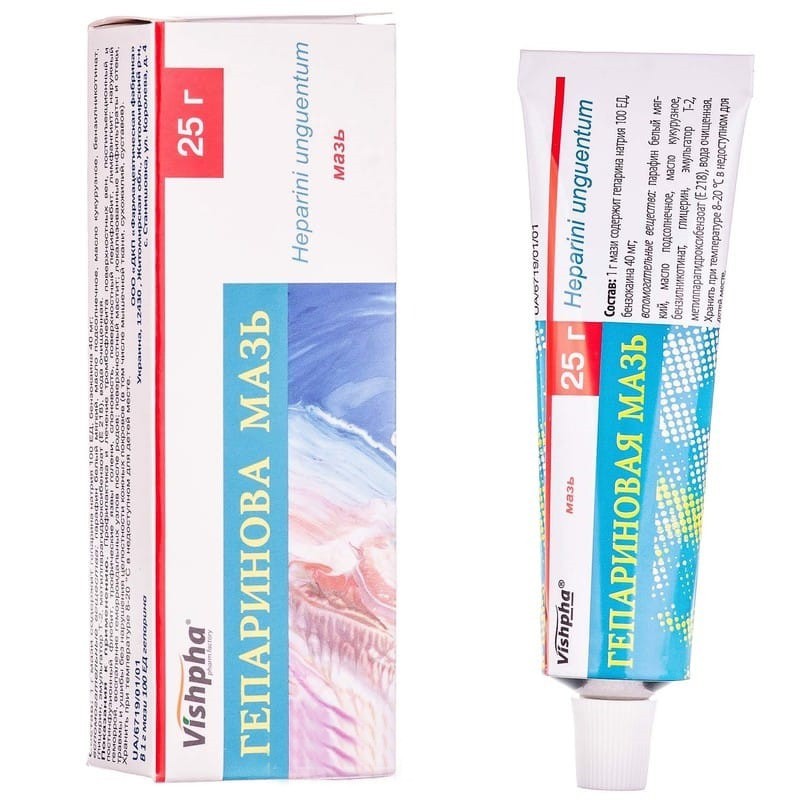



 Secure and encrypted payment processing
Secure and encrypted payment processing We ship to over 40 countries including the USA, UK, Europe, Australia and Japan
We ship to over 40 countries including the USA, UK, Europe, Australia and Japan Guaranteed refund or reship if you haven't received your order
Guaranteed refund or reship if you haven't received your orderheparin ointment is a direct-acting anticoagulant, has an anti-inflammatory and local anesthetic effect, prevents the formation of blood clots, and promotes resorption of the formed blood clots.
Pharmacokinetics Not determined.
Prevention and treatment of superficial vein thrombophlebitis; post-injection and post-infusion phlebitis, trophic ulcers of the lower leg, elephantiasis, superficial periphlebitis, lymphangitis; external hemorrhoids, inflammation of the hemorrhoids after childbirth; superficial mastitis; localized infiltrates and swelling, injuries and bruises without violating the integrity of the skin (including muscle tissue, tendons, joints).
The drug is used in adults locally.
For thrombophlebitis of the superficial limb veins, apply the ointment to the affected area with a thin layer (based on 0.5–1 g (2–4 cm of ointment) on a site with a diameter of 3-5 cm) and gently rub into the skin 2-3 times a day for 3 –7 days until the signs of inflammation disappear. The possibility of a long course of treatment is determined by the doctor.
In case of hemorrhoidal vein thrombosis, the ointment should be applied to a tissue napkin, which is directly applied to the hemorrhoidal nodes, and fixed with a bandage (it is possible to use a tampon with ointment applied to it, which should be inserted into the anus) 2-3 times a day until the signs of inflammation disappear, an average of 3-14 days. The possibility of prolonged use is determined by the doctor individually.
Hypersensitivity to any of the components of the drug. ulcerative necrotic processes, traumatic violation of the integrity of the skin, open infected wounds, hemorrhagic diathesis, purpura, thrombocytopenia, hemophilia, tendency to bleeding.
Redness, skin rash, urticaria, angioedema, hemorrhage, sometimes small pustules, vesicles or blisters may occur. possibly local irritant effect, manifested in the form of burning, itching or slight swelling of the skin. the presence of methyl parahydroxybenzoate (e218) in the preparation can cause allergic reactions (possibly delayed type), when applied to large areas of the skin, systemic allergic reactions and hyperemia are possible.
With prolonged use of ointment in large areas and the simultaneous use of oral medications that affect the blood coagulation system and / or blood formation, coagulation time and prothrombin time should be monitored. if necessary, a long course of treatment and application to extensive lesions in women ≥65 years of age, a similar control is recommended.
It should not be applied to open wounds in the presence of purulent processes. The use of ointment is not recommended for deep venous thrombosis.
The drug should not be prescribed for bleeding, applied to the mucous membranes, infected skin, inside the eye and on the areas around the eyes, on ulcers and blisters. In case of blood coagulation disorders, it is not recommended to apply to large areas of the skin.
With thrombocytopenia and an increased tendency to bleeding, the drug should be used under the supervision of a doctor.
Use during pregnancy or lactation. Do not use during pregnancy and lactation.
Children. Do not use.
The ability to influence the reaction rate when driving vehicles or working with other mechanisms. Does not affect.
The action of the ointment is enhanced by anticoagulants, acetylsalicylic acid and other NSAIDs. the effectiveness of ointments is reduced by digitalis preparations, tetracyclines, nicotine, antihistamines. the use of heparin can cause a prolongation of prothrombin time in patients taking oral anticoagulants.it is not recommended to take the drug in combination with topical drugs, for example, with drugs containing tetracycline, hydrocortisone, salicylic acid, with anticoagulants.
Due to the low level of absorption of heparin ointment, its overdose is impossible.
At a temperature of 8–20 ° C out of the reach of children.